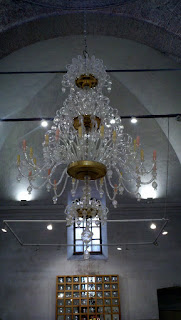So, fun weekend with a lot of travel time. Barcelona was great and the students said they had a fantastic time. Several of them said they want to move there so I am sure it was fun. I will be scouring their Facebook pages over the next few days to find some appropriate photos for the blog so expect something soon.
If you ever doubt your child's ability to be on time, don't. This weekend they were rock stars. On the way to catch our flight in Madrid to Barcelona there was no problem getting to the airport by taking a bus to the train station to the metro and finally to the gate in the afternoon and even MORE impressive was the fact that they were all ready and out the door by 5 am to do the reverse to catch the flight home. Solid. Monday made for a very long day because we arrived at the airport and had to take the metro into Madrid and meet at the Reina Sofía museum at 11 am. So we were a little late. And it was raining. And we were tired. And the metro ride was long. And we had to walk. Yet no one complained. WHO ARE THESE PEOPLE? THANK YOU! With no sleep, little food and a super long travel day everyone was positive and there was no griping. Amazing.
Reina Sofía Museum = Very nice.
Changing last year's policy of, "Please, take photos of everything." to "No photos of the cool stuff" = lame.
Having the foresight last year to know they would pull a stunt like this & photographing everything = priceless.
Here are links to photos of everything in their museum from last year and this year:
2010 Fotos
2011 Fotos
After the museum we took a 20 minute forced march with Luis (I mean a leisurely stroll) to th Tapestry Museum which is always impressive but alas - no photos.
The Fábrica de Tapices produces and restores tapestries using 18th century techniques. The oldest tapestry they house dates back to the 15thcentury. They also are commissioned to make rugs which are gorgeous but the tapestries will certainly blow your mind.
They use a lot of wool and I believe all of it is from Spain
We thought about bringing one home as a gift but weren’t sure if we had enough money: rugs cost 1,500 euros / meter squared and take 2 weeks to be completed and the tapestries cost 12,000 euros / meter squared and take 4 months to complete. A typical commissioned work in the past would have been a portrait like this one of Alfonso XIII
However, as you can see, their work in general is quite spectacular and detail oriented.
After the museums we ate entirely too much food for lunch and contemplated walking around Madrid for a few hours despite our exhaustion but the torrential downpour that ensued upon our leaving the restaurant forced us to surrender and we headed home to the comfort and warmth of our homes in Segovia.
íHasta luego!


















































